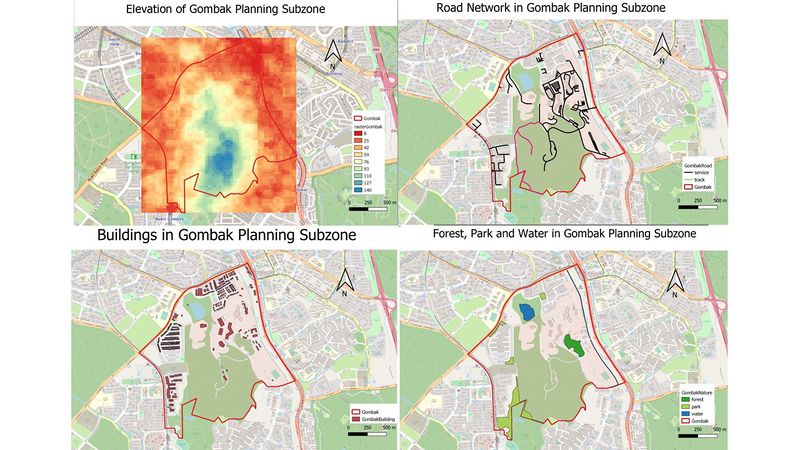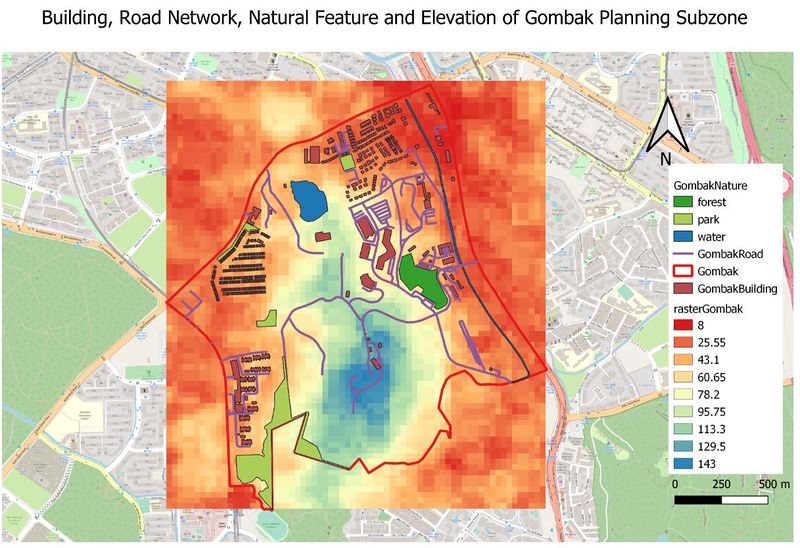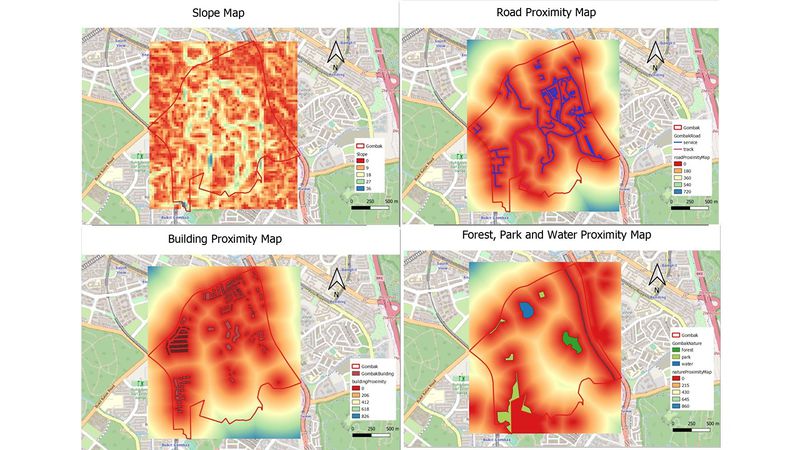Difference between revisions of "SMT201 AY2018-19T1 EX2 Wang Zhuo Wei"
Zw.wang.2016 (talk | contribs) |
Zw.wang.2016 (talk | contribs) |
||
| Line 36: | Line 36: | ||
==Proximity Analysis== | ==Proximity Analysis== | ||
To located the area that is suitable for the site selection and take into consideration of the 4 factors, proximity maps are necessary to identify the distance to each decision factor. For elevation, it should be as low as possible to have better accessibility. Road proximity should be as low as possible to have better transportation. Building proximity should be as high as possible to avoid transmission. Lastly, natural features proximity should be as high as possible to avoid contamination. | To located the area that is suitable for the site selection and take into consideration of the 4 factors, proximity maps are necessary to identify the distance to each decision factor. For elevation, it should be as low as possible to have better accessibility. Road proximity should be as low as possible to have better transportation. Building proximity should be as high as possible to avoid transmission. Lastly, natural features proximity should be as high as possible to avoid contamination. | ||
| + | |||
===Decision Factor 1: Slope=== | ===Decision Factor 1: Slope=== | ||
Slope of Gombak area has a range from 0 to around 36.4 degrees. According to the Slop Map, most areas in Gombak has a slope of less than 17 degrees. Potentially, most areas in Gombak have a less step slope, suitable for site selection. | Slope of Gombak area has a range from 0 to around 36.4 degrees. According to the Slop Map, most areas in Gombak has a slope of less than 17 degrees. Potentially, most areas in Gombak have a less step slope, suitable for site selection. | ||
| + | |||
===Decision Factor 2: Road Proximity=== | ===Decision Factor 2: Road Proximity=== | ||
Proximity to service road and track has a range from 0 to 722 meters. Based on the proximity maps, it is apparent that most of the areas are colored in orange or red as they are less than 180 meters to the road network. | Proximity to service road and track has a range from 0 to 722 meters. Based on the proximity maps, it is apparent that most of the areas are colored in orange or red as they are less than 180 meters to the road network. | ||
| + | |||
===Decision Factor 3: Building Proximity=== | ===Decision Factor 3: Building Proximity=== | ||
| + | Proximity to buildings has a range from 0m to 826m. However, most of the area in Gombak fall within the radius of 206m from buildings, making them not suitable for our site selection. | ||
| + | |||
===Decision Factor 4: Natural Features Proximity=== | ===Decision Factor 4: Natural Features Proximity=== | ||
| + | From the map, we could see that the southeast area of Gombak does not have any natural features, whereas, at other areas, there are water body, forest and park. Because these natural features cover a vast land, it leaves less area for our site selection as most area are within 430m from the boundary of these natural features. | ||
[[File:ZwSlide2.JPG|800px|center]] | [[File:ZwSlide2.JPG|800px|center]] | ||
Revision as of 17:16, 9 November 2019
Contents
Assignment Objective
This assignment aims to identify a location suitable for building a national Communicable Disease Quarantine Centre. The selected site should be located in Gombak planning subzone with a area of at least 10,000 square meters. Additionally, the site selection must fulfill the following decision factors:
Factors to Consider
Economic factor: The selected site should avoid steep slope.
Accessibility factor: The selected site should be close to existing local roads, such as service roads and tracks
Health risk factor: The selected site should be away from current buildings
Natural conservation factor: The selected site should be away from forested land, park and water.
Data Collection
Data used for this assignment are gathered from the following sources:
1. Master Plan 2014 Subzone Boundary (No Sea) (SHP) from URA [1]
2. Roads(SHP) from osm[2].
3. Buildings(SHP) from osm [3].
4. Natural(SHP) from osm [4].
5. Raster ASTER Elevation(TIFF) from NASA[5].
Decision Analysis
Decision Factor 1: Economic factor (Slope)
The Economic factor is that the slope should not be too steep so that it is easier to access. In general, the lowest point in Gombak is 8m above sea level, highlighted in red, and the highest point is 145m above sea level, highlighted in blue. From the elevation map, it is obvious that near the border of Gombak, the elevation value is lower. At the centre of Gombak area, the elevation value is higher
Decision Factor 2: Accessibility factor (Road)
The selected site should be close to existing service roads and tracks, so that it allows easy access for vehicles. Most road networks are service roads, highlighted in black and there are only two tracks, highlighted in black. The road networks generally gather at the north east part of Gombak.
Decision Factor 3: Health risk factor (Building)
To avoid transmission of disease, the site selection should be far from buildings. In Gombak, most buildings are located near the northwest and southwest border in huge clusters. The building type ranges from residential to place of warship and clinic. The rest buildings are scatter around different parts of Gombak.
Decision Factor 4: Natural conservation factor(Natural Features)
At Gombak, there are 3 different types of natural features: forest, water and park. The site should be located far from these natural features to avoid contamination and protect the environment. There is 1 water body and 1 forest in the subzone with several parks.
Decision Factors Aggregation
By combining the 4 decision factors into 1 map, we could see that there is space available near the south border of Gombak. This area could be the potential area for our site selection but given that it satisfies all the factors at the first place.
Proximity Analysis
To located the area that is suitable for the site selection and take into consideration of the 4 factors, proximity maps are necessary to identify the distance to each decision factor. For elevation, it should be as low as possible to have better accessibility. Road proximity should be as low as possible to have better transportation. Building proximity should be as high as possible to avoid transmission. Lastly, natural features proximity should be as high as possible to avoid contamination.
Decision Factor 1: Slope
Slope of Gombak area has a range from 0 to around 36.4 degrees. According to the Slop Map, most areas in Gombak has a slope of less than 17 degrees. Potentially, most areas in Gombak have a less step slope, suitable for site selection.
Decision Factor 2: Road Proximity
Proximity to service road and track has a range from 0 to 722 meters. Based on the proximity maps, it is apparent that most of the areas are colored in orange or red as they are less than 180 meters to the road network.
Decision Factor 3: Building Proximity
Proximity to buildings has a range from 0m to 826m. However, most of the area in Gombak fall within the radius of 206m from buildings, making them not suitable for our site selection.
Decision Factor 4: Natural Features Proximity
From the map, we could see that the southeast area of Gombak does not have any natural features, whereas, at other areas, there are water body, forest and park. Because these natural features cover a vast land, it leaves less area for our site selection as most area are within 430m from the boundary of these natural features.



